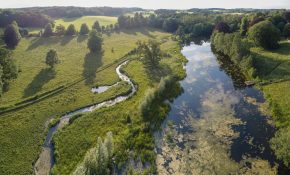Observations from a farm adviser
Following the recent rainfall event, I had an interesting couple of hours driving the back roads and lanes of the Bure Catchment to see the impact of such an intense storm. My little home rain gauge indicated that approximately 40mm had fallen in just a few hours on that Sunday morning, but I’ve since been told some areas of Norfolk received up to 85mm. By the following morning, most of the flood water had receded, just leaving the silt evidence on roads, in ponds and in field corners. Interestingly, it wasn’t always the most obvious places where water had clearly left a field – often it had come through hedges, although gateways were by far the most common field-exit pathway.
I traced silt for many miles up roads until I reached an obvious source, and in 90% of cases the source was a potato field, mostly coming out of gateways. The second most common were tracks and property gateways, with a couple of areas of maize also contributing to run-off. I saw no obvious evidence of water coming off cereal crops, except for one field where a very compacted headland tramline ran directly from a gateway up a slope.
We often hear ‘but that was a one-off storm, it doesn’t normally run-off like that’. The second part of that statement may well be true, however, the first part is now no longer the case. We must re-assess our farms and growing practices with that in mind. What this rain event highlighted was that potatoes are a vulnerable crop EVERY year. At this time of year, there is no top growth for protection, soil is often capped after a summer of irrigation, and compaction is often an issue too.
So, here are some thoughts on how to start mitigating some of the risks of soil loss from growing potatoes and other bed crops:
- Fields where potatoes will be grown at some point need WIDE (10m min but wider depending on the length of slope), ROUGH grass margins along all field edges at the bottom of any slope and NO driving or parking on buffers, not even occasionally.
- Thought should be given IF a field is vulnerable due to slope or gateways – SHOULD bed crops be grown on that field?
- Gateways must all be properly assessed, and those at risk of creating pathways for soil and water to leave a field should be moved. If an alternative gateway is not possible, then existing levels should be raised to prevent water in extreme weather events leaving the field.
- Create in-field grass buffers, particularly in fields with ‘multiple facing’ slopes, to block pathways and reduce the energy of water within the field.
- Make use of machinery such as the Briggs Tied Ridger, Bye Engineering Wonder Wheel and Creyke Wheel Track Roller (free to trial under our Water Sensitive Farming Initiative) to mitigate compacted wheelings and re-direct water flow back into the crop, away from the tramline and bed pathways. Repeat passes later in the season and after canopy destruction, when bare soils are particularly vulnerable.
- Continue to work on improving soil organic matter, extending crop rotations, minimising trafficking, incorporating grass leys into rotations, using trees and hedges to break slopes and changing headland tramline direction. In addition, the use of double headland tramlines on particularly vulnerable locations is also important.










